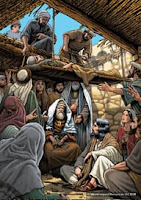
Just finished the story of the
healing of the paralyzed man from Mark ch2. There are six pictures in this set which brings our total Bible picture count to 758.
Picture one shows the four men with their friend on a stretcher outside the crowded house. One of the men is pointing upwards towards the roof. Picture 2 shows two of the men taking their friend up the exterior steps built into the side of the house, while another is starting to break up the roof. You can see the 2 foot high parapet wall around the top of the roof, a building regulation laid down in Deut 22:8.
Breaking through the roof seems a little extreme, but apparently this was a common practice in those days for the purpose of lowering down grain, straw and other articles. Dr Thomson in
'The Land and the Book' wrote
"The roof could easily be broken in this manner, and easily repaired." There are many other explanations as to how the roof was taken up in this story, some required very little damage to the roof itself. It comes down to which theory you prefer. This is not set in stone!
Click here for more information on houses in Bible times.
Picture 3 (above) shows the paralyzed man being lowered down before Jesus. This picture appears on the cover of the new
ICB Gospel of Luke, (only 99p!)
In picture 4 we see Jesus questioning the scribes. When you illustrate a scribe, remember to add an 'inkhorn' hanging from his belt. Inkhorns were long slim boxes about 9-10 inches in length and 2 inches wide. They were made of either a hardwood like ebony or more commonly from metal such as silver, brass or copper. They were exquisitely carved and contained the writing implements used by the scribe. The inkhorn was divided into two parts, the main longer box held the reed pens and a knife, while the smaller 'inkstand', which was a much heavier little box with a hinged lid, held the powered ink. The ink, (which needed water adding to it before it could be used), was made from a mixture of lamp soot or pulverized charcoal and gum. Because this ink was water soluble, it could be easily erased with a sponge and water!
In picture 5, Jesus heals the paralyzed man. In picture 6 the man is following the command of the Lord Jesus by taking up his bed and going home!
This set of pictures will be uploaded to the 'Bible picture website' shortly.

